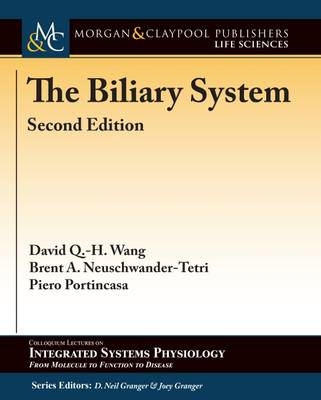
The Biliary System
Seiten
2016
|
2nd Revised edition
Morgan & Claypool Publishers (Verlag)
978-1-61504-737-6 (ISBN)
Morgan & Claypool Publishers (Verlag)
978-1-61504-737-6 (ISBN)
Summarizes the progress in the molecular and cellular mechanisms of cholesterol and bile acid metabolism and the physical-chemistry of biliary lipids, with emphasis on biliary lipid metabolism that is regulated by nuclear receptors in the hepatobiliary system.
The liver is a vital organ involved in numerous metabolic processes such as cholesterol and bile acid metabolism, biliary lipid secretion, and bile formation. Cholesterol balance across the liver has a crucial effect on influencing plasma total and LDL cholesterol levels and biliary cholesterol concentrations. Cholesterol and bile acid biosyntheses are primarily modulated by negative feedback regulatory mechanisms through the sterol regulatory element-binding protein isoform 2 (SREBP-2) and the farnesoid X receptor (FXR) pathways, respectively. The conversion of cholesterol to bile acids in the liver can balance the fecal excretion of bile acids, which is an important route for the removal of cholesterol from the body. Bile formation begins in the bile canaliculi, and maintenance of the enterohepatic circulation of bile acids results in a continuous secretion of bile. Hepatic secretion of biliary lipids is determined mainly by a group of ATP-binding cassette (ABC) transporters that are located on the canalicular membrane of hepatocytes, which are regulated by various nuclear receptors. Bile acids promote bile flow by their osmotic effects. Also, they are essential for the intestinal absorption of cholesterol, fatty acids, and fat-soluble vitamins and play an important role in aiding the digestion of dietary fat. Bile acids function as signaling molecules and anti-inflammatory agents to regulate lipid, glucose, and energy metabolism by rapidly activating nuclear receptors and cell signaling pathways. This eBook summarizes the progress in the molecular and cellular mechanisms of cholesterol and bile acid metabolism and the physical-chemistry of biliary lipids, with emphasis on biliary lipid metabolism that is regulated by nuclear receptors in the hepatobiliary system.
The liver is a vital organ involved in numerous metabolic processes such as cholesterol and bile acid metabolism, biliary lipid secretion, and bile formation. Cholesterol balance across the liver has a crucial effect on influencing plasma total and LDL cholesterol levels and biliary cholesterol concentrations. Cholesterol and bile acid biosyntheses are primarily modulated by negative feedback regulatory mechanisms through the sterol regulatory element-binding protein isoform 2 (SREBP-2) and the farnesoid X receptor (FXR) pathways, respectively. The conversion of cholesterol to bile acids in the liver can balance the fecal excretion of bile acids, which is an important route for the removal of cholesterol from the body. Bile formation begins in the bile canaliculi, and maintenance of the enterohepatic circulation of bile acids results in a continuous secretion of bile. Hepatic secretion of biliary lipids is determined mainly by a group of ATP-binding cassette (ABC) transporters that are located on the canalicular membrane of hepatocytes, which are regulated by various nuclear receptors. Bile acids promote bile flow by their osmotic effects. Also, they are essential for the intestinal absorption of cholesterol, fatty acids, and fat-soluble vitamins and play an important role in aiding the digestion of dietary fat. Bile acids function as signaling molecules and anti-inflammatory agents to regulate lipid, glucose, and energy metabolism by rapidly activating nuclear receptors and cell signaling pathways. This eBook summarizes the progress in the molecular and cellular mechanisms of cholesterol and bile acid metabolism and the physical-chemistry of biliary lipids, with emphasis on biliary lipid metabolism that is regulated by nuclear receptors in the hepatobiliary system.
Saint Louis University School of Medicine Saint Louis University School of Medicine University of Bari Medical School LSU Health Sciences, Shreveport University of Mississippi Medical Center, Jackson
Introduction
Anatomy of the Liver, Biliary Tract, and Gallbladder
Physical Chemistry of Bile
Hepatic Cholesterol Metabolism
Physical Chemistry and Hepatic Metabolism of Bile Acids
The Enterohepatic Circulation of Bile Acids
Hepatic Secretion of Biliary Lipids and Bile Formation
Cholesterol Crystallization and Gallstone Formation
Summary
Acknowledgments
References
Author Biographies
| Erscheinungsdatum | 06.01.2017 |
|---|---|
| Reihe/Serie | Colloquium Series on Integrated Systems Physiology: From Molecule to Function |
| Mitarbeit |
Herausgeber (Serie): D. Neil Granger Ph.D., Joey P. Granger Ph.D. |
| Verlagsort | San Rafael |
| Sprache | englisch |
| Maße | 191 x 235 mm |
| Gewicht | 360 g |
| Themenwelt | Medizin / Pharmazie ► Medizinische Fachgebiete ► Onkologie |
| Studium ► 1. Studienabschnitt (Vorklinik) ► Physiologie | |
| Naturwissenschaften ► Biologie ► Genetik / Molekularbiologie | |
| ISBN-10 | 1-61504-737-9 / 1615047379 |
| ISBN-13 | 978-1-61504-737-6 / 9781615047376 |
| Zustand | Neuware |
| Haben Sie eine Frage zum Produkt? |
Mehr entdecken
aus dem Bereich
aus dem Bereich


